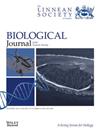espinharado山脉天岛树蛙(无尾目,树蛙科)的谱系多样性
IF 1.5
3区 生物学
Q3 EVOLUTIONARY BIOLOGY
引用次数: 0
摘要
天空群岛为生物进化提供了独特的景观,因为它们由高山峰和低山谷组成,环境条件截然不同。巴西东部的埃斯帕拉索山脉是由米纳斯吉拉斯州和巴伊亚州的天空群岛组成的。几项系统地理学研究发现,在埃斯帕纳帕拉多山区占据campo rupestre (rupestrian田)的生物种群中存在很强的遗传结构。在本研究中,我们的目的是验证在espinhaperdo的campo rupestre的sinax curicica种群的时空结构假设。我们发现了3个S. curicica谱系:1个谱系分布在espinhao北部的Chapada Diamantina地区(north lineage),另外2个谱系分布在espinhao南部的Minas Gerais地区(south 1和south 2)。随着时间的推移,这三个谱系的种群规模都保持稳定,这可能是由于山顶地区的气候稳定,这得到了生态位模型的支持。本文章由计算机程序翻译,如有差异,请以英文原文为准。
Lineage diversification of the Sky Island treefrog Scinax curicica (Anura, Hylidae) in the Espinhaço Mountain Range
Abstract Sky Islands present unique landscapes for organismal evolution because they comprise high mountain peaks separated by low valleys with vastly different environmental conditions. The Espinhaço Mountain Range in eastern Brazil is formed of groups of Sky Islands in the states of Minas Gerais and Bahia. Several phylogeographic studies have discovered strong genetic structure among populations of organisms occupying the campo rupestre (rupestrian fields) in the mountains of the Espinhaço. In this study, we aimed to test the hypothesis of spatio-temporal structuring of populations of Scinax curicica in the campo rupestre of the Espinhaço. We recovered three lineages of S. curicica: one lineage occurs in the north portion of the Espinhaço (North Lineage) in an area called Chapada Diamantina, and other two occur in the south portion of the Espinhaço (South 1 and South 2 Lineages) in Minas Gerais. All three lineages showed stable population sizes through time, probably due to the climatic stability of mountaintop areas, which was supported by ecological niche modelling.
求助全文
通过发布文献求助,成功后即可免费获取论文全文。
去求助
来源期刊
CiteScore
4.30
自引率
10.50%
发文量
140
审稿时长
3-6 weeks
期刊介绍:
The Biological Journal of the Linnean Society is a direct descendant of the oldest biological journal in the world, which published the epoch-making papers on evolution by Darwin and Wallace. The Journal specializes in evolution in the broadest sense and covers all taxonomic groups in all five kingdoms. It covers all the methods used to study evolution, whether whole-organism or molecular, practical or theoretical.d.

 求助内容:
求助内容: 应助结果提醒方式:
应助结果提醒方式:


